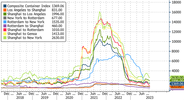Value Collector
Have courage, and be kind.
- Joined
- 13 January 2014
- Posts
- 12,242
- Reactions
- 8,496
I have a theory that the prices are also being inflated to some extent by the Chinese banning Australian coal.
1, there have been some ships full of coal sitting idle, waiting to unload, this ties up some of the supply.
2, China is now importing more coal from USA instead of Australia, which again ties up more ships, because the round trip to the USA takes a lot more time, so each 1 shipment delivered from the USA ties up a ship for 2.5 times as long as a shipment delivered from Australia.
if China begins importing coal from Australia again, we might see more supply of bulk carriers becoming available, as each load requires less sea days.
1, there have been some ships full of coal sitting idle, waiting to unload, this ties up some of the supply.
2, China is now importing more coal from USA instead of Australia, which again ties up more ships, because the round trip to the USA takes a lot more time, so each 1 shipment delivered from the USA ties up a ship for 2.5 times as long as a shipment delivered from Australia.
if China begins importing coal from Australia again, we might see more supply of bulk carriers becoming available, as each load requires less sea days.




